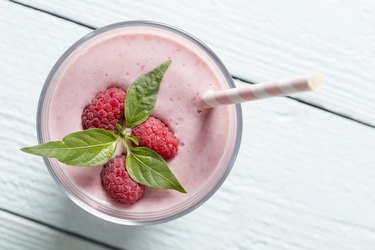
For a small portion of the American population — about 1.7 percent, according to the Centers for Disease Control and Prevention — being underweight is a serious health concern. With your doctor's approval, homemade smoothies or shakes can be part of your weight-gain plan.
The CDC defines being underweight as having a BMI of less than 18.5. If you think you might fall into this underweight category, it's important that you talk to a doctor. Too-low body weight can be a sign of serious health problems, or it can be the cause of further health complications.
Video of the Day
Video of the Day
Smoothie Recipes for Weight Gain
Your weight-gain smoothie starts with a blender and a liquid base — examples include milk, coconut water and milk substitutes such as almond milk. A typical serving is around 8 ounces.
Once you have your base, add a protein source, such as hemp seeds, protein powder or full-fat yogurt.
Next, add fruits, vegetables and nutritious carbohydrates, which the American Academy of Family Physicians recommends as a healthy way to maximize your nutrient intake. Examples of foods that make good additions to your smoothies include:
- Oats
- Ground flax seed
- Cooked sweet potatoes
- Fresh or frozen berries
- Bananas
- Dates
- Mangoes
- Spinach
- Celery
- Cucumbers
The Dana Farber Cancer Institute also recommends increasing the calorie count of your smoothies by adding in calorie-rich foods such as nut butter, avocado, yogurt and healthy oils. These nutritious, fat-rich foods are a good way to increase your calorie intake while nourishing your body.
Tip
Depending on your medical situation, your doctor may set specific calorie goals for your weight-gain smoothies or encourage you to eat as much as you can tolerate.
Read more: Drinks to Help Gain Weight
Check Your Protein Intake
Protein-rich ingredients can be a helpful addition to your smoothies, especially if working out to build muscle is part of your weight-gain program. However, heed a warning from Harvard Health Publications that too much protein can pose serious health problems, including increased risk of kidney disease and kidney stones, constipation, elevated cancer risk and higher risk of cardiovascular disease.
Harvard goes on to note that even among experts, there's disagreement about how much protein is too much. They recommend 2 grams of protein per kilogram of body weight as a cap for most average people who aren't elite athletes or serious bodybuilders — but, when in doubt, it's always best to consult a doctor or dietitian.
More Strategies for Weight Gain
If you are diagnosed as being underweight, that doesn't mean you should pack on the pounds by eating all the ice cream and cupcakes you can get your hands on. Instead, consider these tips from the Mayo Clinic on healthy ways to increase your body weight. With your doctor's approval, you might use them instead of, or in addition to, your weight-gain smoothies:
- Eat five to six small meals during the day, with plenty of snacks in between, instead of two or three large meals.
- Focus on eating lots of nutrient-rich foods, including fruits and vegetables, whole grains, lean protein, and nuts and seeds.
- Try drinking water after your meal instead of before your meal.
- Exercise to build muscle and stimulate your appetite.
If you do work out as part of your weight-gain strategy, keep in mind that exercising burns extra calories. And as the International Sports Sciences Association points out, creating the ideal conditions for muscle growth means maintaining a calorie surplus, or eating more calories than you take in.
- Centers for Disease Control and Prevention: "What Is BMI?"
- Centers for Disease Control and Prevention: "Prevalence of Underweight Among Adults Aged 20 and Over"
- Mayo Clinic: "What a Good Way to Gain Weight if You're Underweight?"
- International Sports Sciences Association: "Building Muscle Simplified: Not as Complicated as You Think"
- Dana Farber Cancer Institute: "How to Gain Weight After Cancer Treatment"
- Harvard Health Publishing: "When It Comes to Protein, How Much Is Too Much?"
- American Academy of Family Physicians: "Healthy Ways to Gain Weight if You're Underweight"